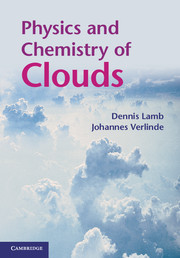Book contents
- Frontmatter
- Contents
- Preface
- Part I Background
- Part II Transformations
- Part III Cloud macrophysics
- Part IV Cloud microphysics
- Part V Cloud-scale and population effects
- 10 Evolution of supersaturation
- 11 Warm clouds
- 12 Cold clouds
- 13 Cloud chemistry
- 14 Cloud electrification
- Appendix A Cloud classification
- Appendix B Overview of thermodynamics
- Appendix C Boltzmann distribution
- References
- Index
12 - Cold clouds
from Part V - Cloud-scale and population effects
Published online by Cambridge University Press: 07 October 2011
- Frontmatter
- Contents
- Preface
- Part I Background
- Part II Transformations
- Part III Cloud macrophysics
- Part IV Cloud microphysics
- Part V Cloud-scale and population effects
- 10 Evolution of supersaturation
- 11 Warm clouds
- 12 Cold clouds
- 13 Cloud chemistry
- 14 Cloud electrification
- Appendix A Cloud classification
- Appendix B Overview of thermodynamics
- Appendix C Boltzmann distribution
- References
- Index
Summary
Overview
Cold clouds, because they often involve both ice and liquid water, are more complicated than warm clouds. But, cold clouds also offer greater opportunities for precipitation formation, and they enhance interactions with radiation. Early in the history of cloud physics, ice formation was thought to be a prerequisite for precipitation in all clouds, but we now realize that the warm-cloud processes of condensation and collision-coalescence are sufficient to produce rain in some clouds (e.g., tropical maritime cumuli), and they can coexist with, even augment, the cold-cloud processes that produce snow, graupel, and hail. The so-called ice-crystal mechanism is required for rain from many continental clouds, even in summertime. The high concentrations of aerosol particles in a continental air mass form many cloud droplets, which leads to competition for the finite supply of excess vapor and limits droplet growth rates. The formation of ice in such situations invariably breaks the colloidal stability of the cloud once it supercools. Cold clouds, of course, are always responsible for wintertime snow. High cirrus clouds are an extreme type of cold cloud, dominated by ice crystals that readily absorb and reradiate infrared radiation.
Both cold and warm clouds produce rain by transforming excess water vapor into condensate that eventually results in large liquid drops falling to the ground. Some of the diverse types of interactions that can take place inside clouds to produce rain are summarized in Fig. 12.1.
- Type
- Chapter
- Information
- Physics and Chemistry of Clouds , pp. 457 - 479Publisher: Cambridge University PressPrint publication year: 2011
- 1
- Cited by



